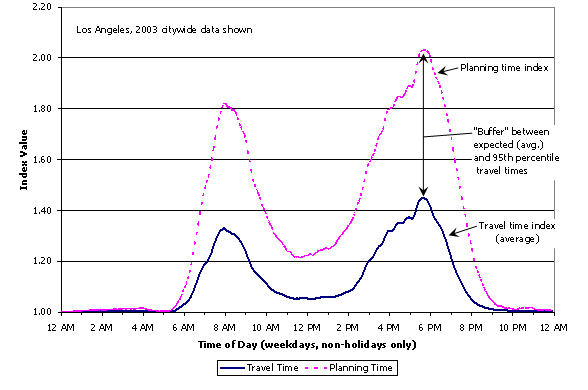Travel Time Reliability Reference Manual/Travel Time Reliability Indices
Reliability Indices
[edit | edit source]Travel Time Index (TTI) - The ratio of a measured travel time during congestion to the time required to make the same trip at free-flow speeds. For example, a TTI of 1.3 indicates a 20-minute free-flow trip required 26 minutes.[1]
Buffer Index (BI) - "The buffer index represents the extra buffer time (or time cushion) that most travelers add to their average travel time when planning trips to ensure on-time arrival. This extra time is added to account for any unexpected delay. The buffer index is expressed as a percentage and its value increases as reliability gets worse. For example, a buffer index of 40 percent means that, for a 20-minute average travel time, a traveler should budget an additional 8 minutes (20 minutes × 40 percent = 8 minutes) to ensure on-time arrival most of the time. In this example, the 8 extra minutes is called the buffer time. The buffer index is computed as the difference between the 95th percentile travel time and average travel time, divided by the average travel time."[2]
"This formulation of the buffer index uses a 95th percentile travel time to represent a near-worst case travel time. Whether expressed as a percentage or in minutes, it represents the extra time a traveler should allow to arrive on-time for 95 percent of all trips. A simple analogy is that a commuter or driver who uses a 95 percent reliability indicator would be late only one weekday per month."[2]
Planning Time Index - "The planning time index represents the total travel time that should be planned when an adequate buffer time is included. The planning time index differs from the buffer index in that it includes typical delay as well as unexpected delay. Thus, the planning time index compares near-worst case travel time to a travel time in light or free-flow traffic. For example, a planning time index of 1.60 means that, for a 15-minute trip in light traffic, the total time that should be planned for the trip is 24 minutes (15 minutes × 1.60 = 24 minutes). The planning time index is useful because it can be directly compared to the travel time index (a measure of average congestion) on similar numeric scales. The planning time index is computed as the 95th percentile travel time divided by the free-flow travel time."[2]
XXth % Travel Time Index - The XXth-percentile travel time index is the ratio of the XXth % travel time to the mean travel time. The XXth-percentile travel time is the travel time at which XX % of travel times are less than or equal to it.
Misery Index (MI) - The misery index measures the amount of delay of the worst trips. For example, the MI may compare the 97.5th percentile travel time to the mean travel time.[3]
On-Time Performance - The percentage of trips which are less than or equal to XX x free-flow travel time, where XX is usually around 1.1-1.3.[3]
Graphical Representation of Travel Time Indices
[edit | edit source]
Previous Page → About the Travel Time Reliability Reference Manual
Travel Time Reliability Reference Manual






